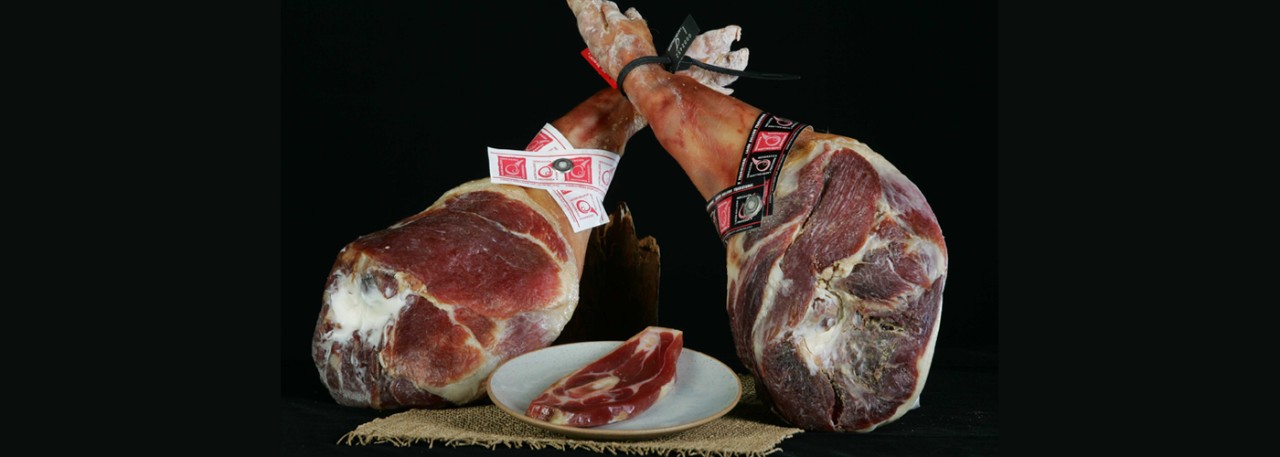.png.transform/rendition-xs/image_image%20(1).png)
Lacón Gallego PGI
Shoulders (fore extremities) from white pigs born and reared in Galicia, of the Celta, Large White, Landrace and Duroc breeds, and their cross-breeds (cross-breeding with the White Belgian and Pietrain breeds is also possible, provided that the percentage is less than 25%), submitted to a salting and drying process of no less than 30 days.
Tasting notes
Slightly sweet flavor with little saltiness, it has a mild and pleasant aroma, with no rancidness or strange smells, firm to the touch.
Other notes
With a round external appearance and trimmed at the edges to where the muscle appears, it retains the skin and hoof, but not the casco (the external covering of the hoof). Its outer appearance is clean, solid and firm to the touch, and its minimum authorized weight is three kilos (6.6 lbs), with a maximum five and a half kilos (12.1 lbs). When sliced its color ranges from red to purple-red, with a clean, shiny appearance and partial fat infiltration. The fat is white or slightly yellow in color, and its creaminess varies depending on the animal’s feed.
Production / Processing method
The pigs used in preparing this protected product must comply with the following prerequisites:
-The pigs must be castrated before entering the rearing period, and the sows should not be in estrous cycle when slaughtered.
-They must be fattened pigs (except boars and sows used for breeding), and be at least six months old, with a minimum weight of 90 kg (198 lbs) when alive.
-During the fattening period the use of any products which may interfere in the animal’s normal growth is strictly prohibited, as is the use of oils, fish meal and their derivatives.
-Slaughter and quartering of the pigs may not take place alongside that of other animals not registered with the Regulatory Council.
-The working and handling of the carcasses, and other pieces to be protected may not take place alongside other pieces not protected by the PGI.
-Likewise, their storage and transport must also be separate and easily controllable. Transport is carried out in refrigerated vehicles, so that the product is kept at a constant temperature of between two and four degrees centigrade (35.6 and 29.2ºF).
-Only the shoulders (fore extremities) with a weight between three and a half kilos and six and a half kilos (7.7 and 14.3 lbs) will be classified.
The pigs arrive at the slaughterhouse following a minimum fasting period of 24 hours, and remain in the barn areas for a maximum of 12 hours. The animals are stunned via electro-shock or other authorized treatment; before being slaughtered, and all blood must be fully drained afterwards.
The channel is aired for a minimum of 24 hours at a temperature of between zero and five degrees centigrade (32 and 41ºF), with relative humidity of between 80 and 90%. Quartering is carried out in accordance with tradition and regulations on the round cut, with the lacón being kept whole and the hoof intact (but with its outer casing removed).
Lacón is made up of the humerus, ulna, radius, carpus, metacarpus and the phalanxes (without the scapula), as well as the muscle tissue attached to these bones and its covering of fat. Once the quartering has taken place, and before the lacones are prepared, the pieces must remain for a minimum of 24 hours in a controlled environment, with a temperature of between two and five degrees centigrade (35.6 and 41ºF) and relative humidity of 80 to 90%.
Production also takes place in a controlled environment, so that the end product acquires its traditional color, aroma and flavor characteristics. Firstly, the shoulders are salted with common salt and nitrifying salts, to encourage the dehydration and preservation of the pieces.
Salting time varies, but is on average one day of salting per kilo (2.2 lbs) of weight. The pieces are then washed in cold or lukewarm water to remove any salt that has become adhered to the surface of the pieces, leaving them to drain for at least one day. During the third stage (resting), the pieces remain hanging in rooms with controlled temperature and relative humidity (temperature of between two and five degrees centigrade (35.6 and 41 ºF) and relative humidity of 80 to 90%).
This stage lasts for a minimum of seven days. The salt is evenly spread throughout all the shoulders, leading to slow, gradual elimination of surface water and improved external consistency for the pieces. Finally, during the curing process the lacones are hung in conditioned areas and natural drying sheds where, via ventilation control that allows optimum temperature and relative humidity conditions to be maintained, they mature for a period of at least 15 days.
The entire production process must last for a minimum of 30 days, and under no circumstances may the lacones be smoked. The PGI product is identified with a plastic seal and rear label, both numbered, with the name and logo of the Regulatory Council.
Geography / Relief and climate
Galicia is located in the extreme northwest of the Iberian Peninsula. Due to its position on the most western point of the European Atlantic arc, the area is a geographical crossroads where specific different ecological factors meet - a north-south climatic and topographical component along with a west-east component where coastal lands meet more inland areas. The difference between the north and south is sharpest in terms of climate and, as a result, soil and vegetation.
Despite its location in wetland Spain, Galicia has certain differences with regards to other regions in Cantabria. Due to its latitude position, it is quite similar to sub-tropical Atlantic climates, and is actually a transition climate, oceanic in the north and sub-oceanic in the south. The first climate is warm and rainy, with maximum rainfall in the winter, minimum in the summer and relatively insignificant drought in the summer. The sub-oceanic area, characterized by the Vigo Baixo Miño estuary and lands surrounding Ourense, has increased drought in the summer, with a minimum of two dry months (July and August), high winter rainfall and higher annual thermal averages.
The combination of a rainy climate with Paleolithic rocks has led to the formation of acidic, under-developed soil, the cultivation of which is limited. This means that poor soils are predominant in Galicia, while the fertile areas represent unique enclaves, normally located at the bottom of valleys or depressions, or on coastal land.
However, thanks to the high levels of humidity and mild temperature, the vegetation cover grows exceptionally well, and the areas most used for grazing are normally on the "peni-plain" zone, characterized by wet, brown soil on silicon materials.
The orographic system and the abundance of rainfall characterize and direct the water flow, with the Navia, Eo, Oro, Landove, Sor, Esteiro, Dola, Baleo, Mayor and Mera rivers on the Cantabrian Sea side and the Tambre, Ulla and Miño Rivers, the longest and most important, in the Atlantic area, which is also home to other minor rivers, such as the Eume, Mandeo, Aliones, Mira, Umia, Lérez, etc., which empty into the estuaries, both higher and lower. Of particular note is the Támega in the southeast of the region (province of Ourense), as it is the only river that does not belong to the northern basin, but rather to the Duero basin.
Regulatory Council
Consejo Regulador de la IGP Lacón Gallego
Recinto Ferial, C/ El Palomar, s/n
27004 Lugo
Galicia
Tel: (+34) 982 243 957 / 881 997 276
info@crlacongallego.com
www.crlacongallego.com
Sources:
Its outer appearance is clean, solid and firm to the touch.


- /content/dam/en/icex-foodswines/images/products/serrano-cured-hams-charcuterie/lacón-gallego-pgi/Lacón%20Gallego%20PGI%20carr1.jpg
- /content/dam/en/icex-foodswines/images/products/serrano-cured-hams-charcuterie/lacón-gallego-pgi/Lacón%20Gallego%20PGI%20carr2.jpg

Lugo (Galicia)
